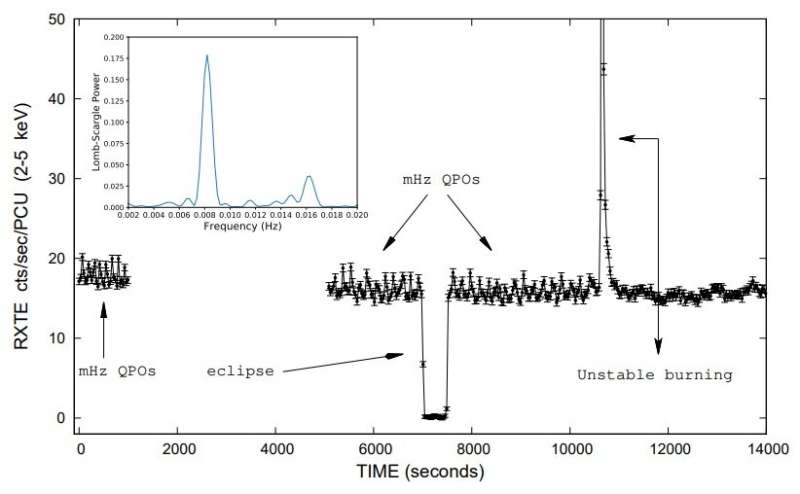May 14, 2019 report
Millihertz quasi-periodic oscillations detected in the X-ray binary EXO 0748−676

By analyzing data from NASA's Rossi X-ray Timing Explorer (RXTE) satellite, astronomers have detected millihertz quasi-periodic oscillations from a low-mass neutron star X-ray binary designated EXO 0748−676. The finding is detailed in a paper published May 6 on the arXiv pre-print server.
X-ray binaries consist of a normal star or a white dwarf transferring mass onto a compact neutron star or a black hole. Based on the mass of the companion star, astronomers divide them into low-mass X-ray binaries (LMXBs) and high-mass X-ray binaries (HMXBs).
Most of the low-mass X-ray binaries containing neutron stars (NS LMXBs) exhibit X-ray variability in the form of relatively sharp quasi-periodic oscillations (QPOs) with millihertz to kilohertz frequencies. It is believed that QPOs occur when X-rays are emitted near the inner edge of an accretion disk in which gas swirls onto a compact object like a neutron star or a black hole. Hence, astronomers hope that finding new objects with such oscillations could improve our knowledge about the innermost regions of accretion disks.
Located most likely between 19,200 and 24,100 light years away, EXO 0748−676 is a transient NS LMXB discovered in 1985. With an orbital period of about 3.82 hours, the source showcases several-minutes-long eclipses in its X-ray light curve and irregular X-ray dips observed mostly in the half orbital cycle prior to the eclipse. First QPOs from this object at kilohertz frequencies were discovered in 2010.
Now, combing through the data gathered by RXTE over a timespan of nearly 15 years, a team of astronomers led by Giulio Cesare Mancuso from the National University of La Plata, Argentina, has found that EXO 0748−676 also exhibits millihertz QPOs.
"We report the discovery of millihertz quasi-periodic oscillations (mHz QPOs) from the bursting, high-inclination atoll neutron-star low-mass X-ray binary (NS LMXB) EXO0748–676 with the Rossi X-ray Time Explorer (RXTE)," the astronomers wrote in the paper.
According to the study, the researchers were able to identify QPOs from EXO 0748−676 with frequencies ranging from 5.0 to 13 millihertz. The amplitude of the QPOs was about 4.0 percent at low energy (between 2.0 and 5.0 keV), and the astronomers also found that in at least two cases, the frequency of these oscillations decreased in time.
Moreover, the astronomers noted that all the detections of QPOs occurred when the source energy spectrum was relatively soft. In one case, they found that the millihertz quasi-periodic oscillation disappeared after the onset of a thermonuclear X-ray burst. The study explains that millihertz QPOs like these detected in EXO 0748−676 are assumed to be due an oscillatory mode of helium burning on the surface of neutron stars, known as the marginally stable nuclear burning.
Summing up their study, the authors noted that the detection makes EXO 0748–676 so far the sixth source with millihertz QPOs associated to marginally stable burning. They added that the results from RXTE also confirm this binary as the second one that shows a systematic frequency drift.
More information: Discovery of millihertz quasi-periodic oscillations in the X-ray binary EXO 0748—676, arXiv:1905.01956 [astro-ph.HE] arxiv.org/abs/1905.01956
© 2019 Science X Network



















